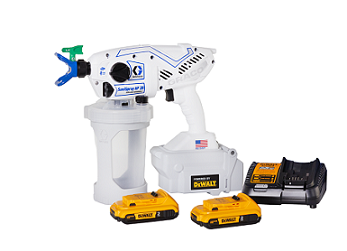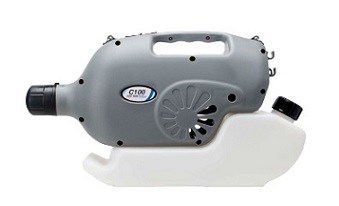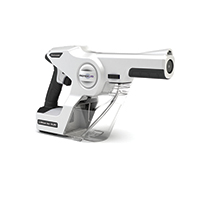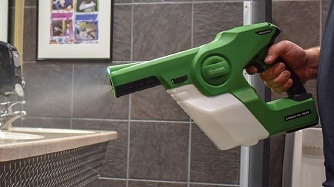Green Lodging News asked Nina Hwang, MPH, Senior Scientist at Green Seal, about the use of foggers and electrostatic sprayers. Click here to read those questions and answers.
NATIONAL REPORT—When MGM Resorts International outlined its Seven-Point Safety Plan for dealing with COVID-19 in a press release last month, it included the use of electrostatic sprayers for large public spaces “so that disinfectant is applied efficiently.” Numerous other companies have also committed to using electrostatic sprayers for public spaces. HEI Hotels & Resorts said it would use them in public and private spaces. Marriott, in its April announcement about its new cleanliness standards, said it is rolling out electrostatic sprayers with hospital-grade disinfectant to sanitize surfaces throughout the hotel.
“Electrostatic spraying technology uses the highest classification of disinfectants recommended by the Centers for Disease Control and Prevention (CDC) and World Health Organization (WHO) to treat known pathogens,” Marriott said in its statement. “The sprayers rapidly clean and disinfect entire areas and can be used in a hotel setting to clean and disinfect guestrooms, lobbies, gyms and other public areas.”
Electrostatic sprayers are just one of four main options for disseminating disinfectant. Dan Johnson, Global Total Markets Manager, Contractor Equipment Division, Graco Inc., says simple spray bottle type sprayers, electrostatic sprayers, foggers (fog sprayers) and his company’s recently introduced airless disinfectant sprayers are four main options to consider.
Spraying disinfectant should not be done without a plan. “Spray based on what the chemical company recommends,” Johnson says. The EPA provides a long list of disinfectants for use against COVID-19.

The Birth of SaniSpray HP
Graco has been making fluid handling equipment for a long time. “We were formed in 1926 in Minneapolis, making lubrication equipment for vehicles,” Johnson says. “That pumping technology can be used in other industries. When COVID-19 came along, we asked, ‘How can we assist in this fight? That is when SaniSpray HP was born.”
SaniSpray HP consists of pressuring fluid and pushing it through a small orifice. Graco provides five models of sprayers—each offering speed and productivity, Johnson says. Three tips are available: fine mist, medium, and coarse tip. He recommends the SaniSpray HP 20 for hotels. The cordless handheld sprayer offers a maximum flow of 20 ounces per minute. For larger areas one could go as large as a SaniSpray 130 (130 ounces per minute). Two hoses can be run off the unit. There are also other Graco sprayer options.
“We deliver consistent atomization and complete coverage,” Johnson says. “It is important that there be complete coverage, or the disinfectant cannot do its job.”
Johnson says his company’s line of products have been an immediate success and are the only airless sprayers specifically built for disinfecting.
Pineapple Hospitality currently offers not only Graco products but also the Vector Fog C100+. “The compact Vector Fog C100+ cold fogging machine is one of the most powerful and durable ULV machines in the market today,” Pineapple says. “Equipped with our exclusive 1,170-watt motor, this fogger can produce a powerful flow rate of 60 LPH (16 GPH) and can easily cover an area of 100 m² in less than a minute. With an adjustable droplet size between 5-50 microns, this fogger can quickly apply disinfectants, biocides, or insecticides to eradicate vectors, carriers and pests.”
Foggers & Electrostatic Sprayers
In its recently released “Guidelines for Safer COVID-19 Cleaning and Disinfection,” Green Seal said some technologies being marketed for controlling COVID-19 unnecessarily increase hazardous exposures, and others require more proof of efficacy and safety.
“Both CDC and EPA discourage using a fogger to saturate the air in a room with disinfectant,” Green Seal says. “This method has not been proven more effective than other methods of application, and it can lead to hazardous exposures because of the amount of disinfectant used.”

With foggers, what you put in it matters a lot. “Only use application methods that are listed on the disinfectant’s label,” Green Seal encourages. “If instructions for a specific method are not found on the label, it means that the EPA has not reviewed any data on whether the product is effective or safe when applied this way.”
The use of electrostatic sprayers in hotel environments is not new in terms of dispensing disinfectant products, says Ray Burger, President of Pineapple Hospitality. They are also used for painting and pesticide delivery.
Burger expressed confidence in the safety of electrostatic sprayers for the dissemination of disinfectants. “Disinfectant is 95 percent water,” Burger says. “If you dispense it, you are not using much disinfectant.”

Guest Supply Chooses EvaClean
Guest Supply by Sysco is currently selling EvaClean products including the EvaClean Protexus Professional Cordless Electrostatic Sprayer. “It is a single nozzle, 60-micron sprayer instead of a multi nozzle sprayer,” says Ashley Bellucci, Director of Product Marketing for Guest Worldwide. “This single nozzle sprayer was specifically developed around the use of our recommended chemical solution, allowing for little variability in saturation and dry time, and simplified training for hotel staff.”
The EvaClean sprayer utilizes PURTABS tablets to make the disinfectant. “You just drop the PURTABs into the tank with tap water and it creates a hypochlorous acid solution for surface disinfection,” Bellucci says. “Wearing a mask and gloves during spraying is not mandatory but we recommend it during typical cleaning protocol. We are being very careful with what chemicals we are recommending.”
Victory Innovations Co., a producer of electrostatic sprayers, has had so much business lately that it does not expect to have inventory until November. It offers cordless backpack sprayers and handheld sprayers.
According to the company, its “Professional Cordless Electrostatic Sprayer allows the user hours of spraying time without the hassle of dragging a cord. In addition, it is designed to save time and labor, spray less liquid, and cover more surfaces. Victory Sprayers’ patented technology provides an electrical charge to solutions, allowing them to wrap conductive surfaces with an effective and even coverage. Double-charged particles envelope all conductive surfaces—shadowed, vertical and underneath.
PPE Recommended
For those using sprayers and foggers, Burger recommends a mask, goggles, “maybe a face shield…maybe a suit.” Training and proper PPE should be implemented before the use of any disinfectant regardless of the method of application.

In regard to electrostatic sprayers, Green Seal added, “Electrostatic sprayer devices spray disinfectant through a nozzle containing an electrode that charges the droplets. The charged droplets are repelled from one another but attracted to neutrally charged environmental surfaces, thus wrapping around an object, and settling in an even layer on all sides of the item. There is evidence that electrostatic sprayer application reduces total consumption of chemicals due to its improved coverage rate; however, this application and its associated reduced product usage is still undergoing review by EPA and CDC for both safety and effectiveness.”
Many suppliers of disinfectants may not be aware that using their product in an electrostatic sprayer, especially with a disinfecting claim, is not allowed currently in Canada.
Guestroom Best Practices
After spraying or fogging in a guestroom, Burger recommends waiting an hour before putting a guest in the room. “Everything should dry within minutes on hard surfaces,” Burger says. “I recommend using it on every surface after the room has been cleaned. Use it in a room that is ready to be turned over.” “Maybe you don’t spray the artwork,” Burger adds.
Why else would a hotel want to use an electrostatic sprayer or similar device? “It can be more efficient, faster, more thorough, and something you can market to your hotel guests—to reassure them that you are doing everything you can to protect them from the virus,” Burger says.
Cost varies of course depending on the type of sprayer but pricing for powered dispensing systems can range from the hundreds to low thousands of dollars.
The Four C’s
No matter what option you choose for disinfecting, keep the four “C’s” in mind:
Chemistry—The type of chemical that is being used for destroying or inactivating the germ.
Concentration—The level at which that chemical is diluted in solution of water.
Contact time—The amount of time it takes for the disinfectant to sit on a surface before a certain pathogen is inactivated. For example, bleach can take 30 seconds to render a surface free of active E. coli or three minutes for C. difficile spores.
Coverage—The amount of surface area that the disinfectant covers after it is applied. Ideally this is 100 percent.
Guest Supply’s Bellucci offered the following advice when considering a sprayer for disinfecting: “Information on these sprayers is changing on a daily basis,” she says. “There are so many differences between them. It is important to read what the safety protocols are. Before purchasing a sprayer, read what is approved by the EPA to go through it. Do as much research as you can. Read up on the manufacturer. Ask for documentation. There can be health risks when using these sprayers if you do not know the correct protocol to follow.”
Glenn Hasek can be reached at greenlodgingnews@gmail.com.





